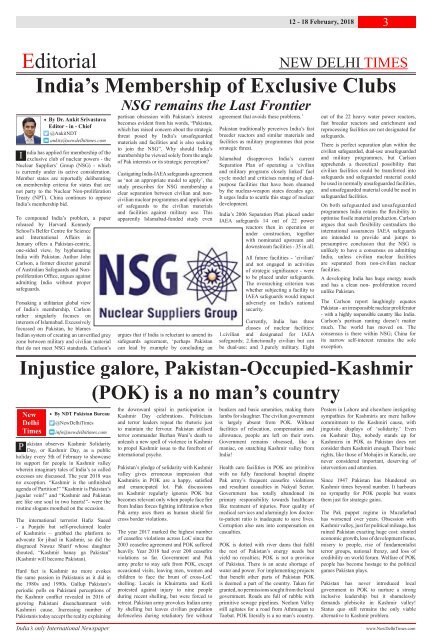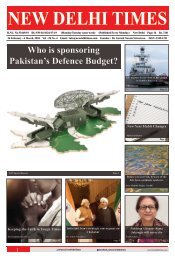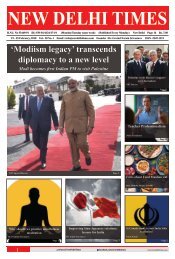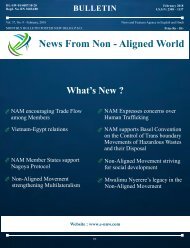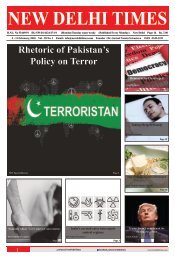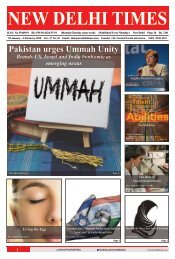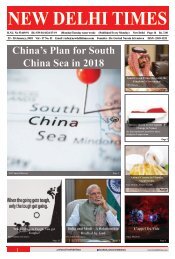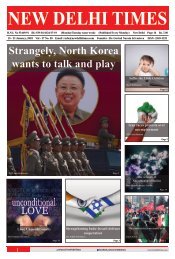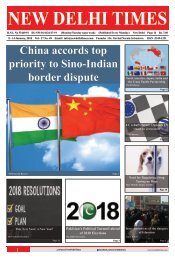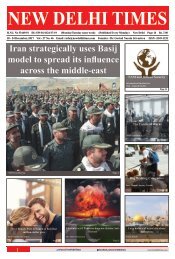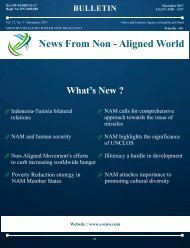12-18 February 2018 - 16-min
Create successful ePaper yourself
Turn your PDF publications into a flip-book with our unique Google optimized e-Paper software.
<strong>12</strong> - <strong>18</strong> <strong>February</strong>, 20<strong>18</strong> 3<br />
I<br />
P<br />
Editorial<br />
◆◆<br />
By Dr. Ankit Srivastava<br />
Editor - in - Chief<br />
@AnkitNDT<br />
ankits@newdelhitimes.com<br />
NEW DELHI TIMES<br />
India’s Membership of Exclusive Clubs<br />
ndia has applied for membership of the<br />
exclusive club of nuclear powers - the<br />
Nuclear Suppliers’ Group (NSG) - which<br />
is currently under its active consideration.<br />
Member states are reportedly deliberating<br />
on membership criteria for states that are<br />
not party to the Nuclear Non-proliferation<br />
Treaty (NPT). China continues to oppose<br />
India’s membership bid.<br />
To compound India’s problem, a paper<br />
released by Harvard Kennedy<br />
School’s Belfer Centre for Science<br />
and International Affairs in<br />
January offers a Pakistan-centric,<br />
one-sided view, by hyphenating<br />
India with Pakistan. Author John<br />
Carlson, a former director general<br />
of Australian Safeguards and Nonproliferation<br />
Office, argues against<br />
admitting India without proper<br />
safeguards.<br />
Forsaking a utilitarian global view<br />
of India’s membership, Carlson<br />
rather singularly focuses on<br />
interests of Islamabad. Excessively<br />
focussed on Pakistan, he blames<br />
Indian system of creating an unverified grey<br />
zone between military and civilian material<br />
that do not meet NSG standards. Carlson’s<br />
◆◆<br />
By NDT Pakistan Bureau<br />
@NewDelhiTimes<br />
info@newdelhitimes.com<br />
NSG remains the Last Frontier<br />
partisan obsession with Pakistan’s interest<br />
becomes evident from his words, “Pakistan,<br />
which has raised concern about the strategic<br />
threat posed by India’s unsafeguarded<br />
materials and facilities and is also seeking<br />
to join the NSG”. Why should India’s<br />
membership be viewed solely from the angle<br />
of Pak interests or its strategic perception?<br />
Castigating India-IAEA safeguards agreement<br />
as ‘not an appropriate model to apply’, the<br />
study prescribes for NSG membership a<br />
clear separation between civilian and noncivilian<br />
nuclear programmes and application<br />
of safeguards to the civilian materials<br />
and facilities against military use. This<br />
apparently Islamabad-funded study even<br />
argues that if India is reluctant to amend its<br />
safeguards agreement, ‘perhaps Pakistan<br />
can lead by example by concluding an<br />
agreement that avoids these problems.’<br />
Pakistan traditionally perceives India’s fast<br />
breeder reactors and similar materials and<br />
facilities as military programmes that pose<br />
strategic threat.<br />
Islamabad disapproves India’s current<br />
Separation Plan of operating a ‘civilian<br />
and military programs closely linked’ fuel<br />
cycle model and criticises running of dualpurpose<br />
facilities that have been shunned<br />
by the nuclear-weapon states decades ago.<br />
It urges India to scuttle this stage of nuclear<br />
development.<br />
India’s 2006 Separation Plan placed under<br />
IAEA safeguards 14 out of 22 power<br />
reactors then in operation or<br />
under construction, together<br />
with no<strong>min</strong>ated upstream and<br />
downstream facilities - 35 in all.<br />
All future facilities - ‘civilian’<br />
and not engaged in activities<br />
of strategic significance - were<br />
to be placed under safeguards.<br />
The overarching criterion was<br />
whether subjecting a facility to<br />
IAEA safeguards would impact<br />
adversely on India’s national<br />
security.<br />
Currently, India has three<br />
classes of nuclear facilities:<br />
1.civilian and designated for IAEA<br />
safeguards; 2.functionally civilian but can<br />
be dual-use; and 3.purely military. Eight<br />
out of the 22 heavy water power reactors,<br />
fast breeder reactors and enrichment and<br />
reprocessing facilities are not designated for<br />
safeguards.<br />
There is perfect separation plan within the<br />
civilian safeguarded, dual-use unsafeguarded<br />
and military programmes, but Carlson<br />
apprehends a theoretical possibility that<br />
civilian facilities could be transferred into<br />
safeguards and safeguarded material could<br />
be used in normally unsafeguarded facilities,<br />
and unsafeguarded material could be used in<br />
safeguarded facilities.<br />
On both safeguarded and unsafeguarded<br />
programmes India retains the flexibility to<br />
optimise fissile material production. Carlson<br />
argues that such flexibility contradicts the<br />
international assurances IAEA safeguards<br />
are intended to provide and jumps to<br />
presumptive conclusion that the NSG is<br />
unlikely to have a consensus on admitting<br />
India, unless civilian nuclear facilities<br />
are separated from non-civilian nuclear<br />
facilities.<br />
A developing India has huge energy needs<br />
and has a clean non- proliferation record<br />
unlike Pakistan.<br />
The Carlson report laughingly equates<br />
Pakistan - an irresponsible nuclear proliferator<br />
- with a highly responsible country like India.<br />
Carlson’s partisan ranting doesn’t matter<br />
much. The world has moved on. The<br />
consensus is there within NSG; China for<br />
its narrow self-interest remains the sole<br />
exception.<br />
Injustice galore, Pakistan-Occupied-Kashmir<br />
akistan observes Kashmir Solidarity<br />
Day, or Kashmir Day, as a public<br />
holiday every 5th of <strong>February</strong> to showcase<br />
its support for people in Kashmir valley<br />
wherein imaginary tales of India’s so called<br />
excesses are discussed. The year 20<strong>18</strong> was<br />
no exception. “Kashmir is the unfinished<br />
agenda of Partition!” “Kashmir is Pakistan’s<br />
jugular vein!” and “Kashmir and Pakistan<br />
are like one soul in two hearts!”- were the<br />
routine slogans mouthed on the occasion.<br />
The international terrorist Hafiz Saeed<br />
- a Punjabi but self-proclaimed leader<br />
of Kashmiris – grabbed the platform to<br />
advocate for jihad in Kashmir, so did the<br />
disgraced Nawaz Sharif whose daughter<br />
shouted, “Kashmir banay ga Pakistan”<br />
(Kashmir will become Pakistan).<br />
Hard fact is Kashmir no more evokes<br />
the same passion in Pakistanis as it did in<br />
the 1980s and 1990s. Gallup Pakistan’s<br />
periodic polls on Pakistani perceptions of<br />
the Kashmir conflict revealed in 20<strong>16</strong> of<br />
growing Pakistani disenchantment with<br />
Kashmiri cause. Increasing number of<br />
Pakistanis today accept the reality explaining<br />
(POK) is a no man’s country<br />
the downward spiral in participation in<br />
Kashmir Day celebrations. Politicians<br />
and terror leaders repeat the rhetoric just<br />
to maintain the fervour. Pakistan utilised<br />
terror commander Burhan Wani’s death to<br />
unleash a new spell of violence in Kashmir<br />
to propel Kashmir issue to the forefront of<br />
international psyche.<br />
Pakistan’s pledge of solidarity with Kashmir<br />
valley gives erroneous impression that<br />
Kashmiris in POK are a happy, satisfied<br />
and emancipated lot. Pak discussions<br />
on Kashmir regularly ignores POK but<br />
becomes relevant only when people face fire<br />
from Indian forces fighting infiltration when<br />
Pak army uses them as human shield for<br />
cross border violations.<br />
The year 2017 marked the highest number<br />
of ceasefire violations across LoC since the<br />
2003 ceasefire agreement and POK suffered<br />
heavily. Year 20<strong>18</strong> had over 200 ceasefire<br />
violations so far. Government and Pak<br />
army prefer to stay safe from POK, except<br />
occasional visits, leaving men, women and<br />
children to face the brunt of cross-LoC<br />
shelling. Locals in Khuirratta and Kotli<br />
protested against injury to nine people<br />
during recent shelling, but were forced to<br />
retreat. Pakistan army provokes Indian army<br />
by shelling but leaves civilian population<br />
defenceless during retaliatory fire without<br />
bunkers and basic amenities, making them<br />
lambs for slaughter. The civilian government<br />
is largely absent from POK. Without<br />
facilities of relocation, compensation and<br />
allowance, people are left on their own.<br />
Government remains obsessed, like a<br />
maniac, on snatching Kashmir valley from<br />
India!<br />
Health care facilities in POK are primitive<br />
with no fully functional hospital despite<br />
Pak army’s frequent ceasefire violations<br />
and resultant casualties in Nakyal Sector.<br />
Government has totally abandoned its<br />
primary responsibility towards healthcare<br />
like treatment of injuries. Poor quality of<br />
medical services and alar<strong>min</strong>gly low doctorto-patient<br />
ratio is inadequate to save lives.<br />
Corruption also eats into compensation on<br />
casualties.<br />
POK is dotted with river dams that fulfil<br />
the rest of Pakistan’s energy needs but<br />
yield no royalties; POK is not a province<br />
of Pakistan. There is an acute shortage of<br />
water and power. For implementing projects<br />
that benefit other parts of Pakistan POK<br />
is deemed a part of the country. Taken for<br />
granted, no permissions sought from the local<br />
government. Roads are full of rubble with<br />
primitive sewage pipelines. Neelum Valley<br />
still agitates for a road from Athmuqam to<br />
Taobat. POK literally is a no man’s country.<br />
Posters in Lahore and elsewhere instigating<br />
sympathies for Kashmiris are mere hallow<br />
commitment to the Kashmiri cause, with<br />
jingoistic displays of ‘solidarity.’ Even<br />
on Kashmir Day, nobody stands up for<br />
Kashmiris in POK as Pakistan does not<br />
consider them Kashmiri enough. Their basic<br />
rights, like those of Mohajirs in Karachi, are<br />
never considered important, deserving of<br />
intervention and attention.<br />
Since 1947 Pakistan has blundered on<br />
Kashmir times beyond number. It harbours<br />
no sympathy for POK people but wants<br />
them just for strategic gains.<br />
The Pak puppet regime in Muzafarbad<br />
has worsened over years. Obsession with<br />
Kashmir valley, just for political mileage, has<br />
ruined Pakistan exacting huge cost: stunted<br />
economic growth, loss of development focus,<br />
misery to people, rise of fundamentalist<br />
terror groups, national frenzy, and loss of<br />
credibility on world forum. Welfare of POK<br />
people has become hostage to the political<br />
games Pakistan plays.<br />
Pakistan has never introduced local<br />
government in POK to nurture a strong<br />
inclusive leadership but it shamelessly<br />
demands plebiscite in Kashmir valley!<br />
Status quo still remains the only viable<br />
alternative to Kashmir problem.<br />
India’s only International Newspaper<br />
www.NewDelhiTimes.com


